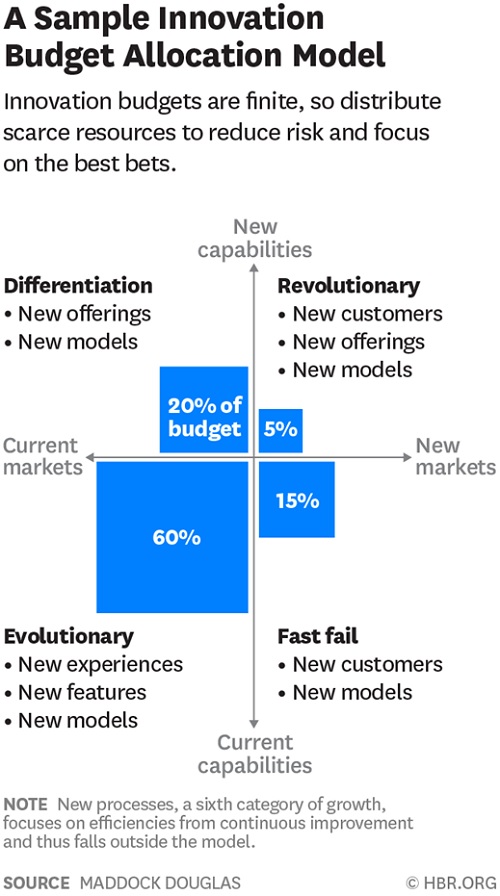Six Ways to Grow a Company
Introduction
Innovation is the key to growth.
Deciding which way to grow should be intentional rather than luck.
Growth Categories
The 6 categories for growth are
i) new processes (sell the same products and/or services at higher margin by cutting costs, automating, etc)
ii) new experiences (excel in customer service so as to retain current customers)
iii) new features (enhance products and/or services by adding incremental improvements to current products and/or services)
iv) new customers (sell your current products and/or services to new people and/or markets)
v) new offerings (sell new products and/or services to existing markets)
vi) new models (sell your products and/or services in a different way, ie
"...reimagine how to go to market by creating new revenue streams, channels, and ways of creating value..."
Gino Chirio, 2018)
Innovation Budget Allocation Model
The allocation of scarce resources should aim to reduce risk and focused on the best bets.
The model below shows the relationship amongst 6 growth categories, ie the 4 quadrants are evolutionary, differentiation, fast fail and revolutionary

NB
"...- new processes fall outside innovation portfolio (no budget allocation)
- new experiences and new features are in the evolutionary quadrant (about 40 - 60% of the budget)
- new offerings are in the differentiation quadrant (about 10 - 20% of the budget)
- a combination of both new customers and new offerings are in the revolutionary quadrant (about 5% - 10% of the budget)
- new models can fall anywhere in the portfolio..."
Gino Chirio, 2018
Excluded is cutting costs as it is just a cheaper way to do things that doesn't necessarily create value in a market, only incremental growth and continuous improvement.
The easiest way to grow is through enhancements, ie new features of your current offerings or experiences that deliver them; this focuses on your known market and existing products and/or services.
Fast fail depends upon experimentation, ie making many small bets and quickly abandoning those that fail.
Differentiation depends on being first to develop new offerings, ie you know the market wants them but are unsure how to deliver, thus making it worthwhile to try
"...Efforts like these carry greater risks a promise greater rewards if you're first to market..."
Gino Chirio, 2018
Revolutionary involves high-risk opportunities with new offerings to new customers; focus on the ideas and understand which parts drive value through continuous assessment of desirability as you are unsure of what the market values; need to test and experiment quickly
Summary
"...Knowing the type of growth that your initiatives represent and their place in the portfolio helps determine which to pursue..."
Gino Chirio, 2018
This is better than placing random bets on opportunities in the hope of getting lucky or looking for a silver bullet.
